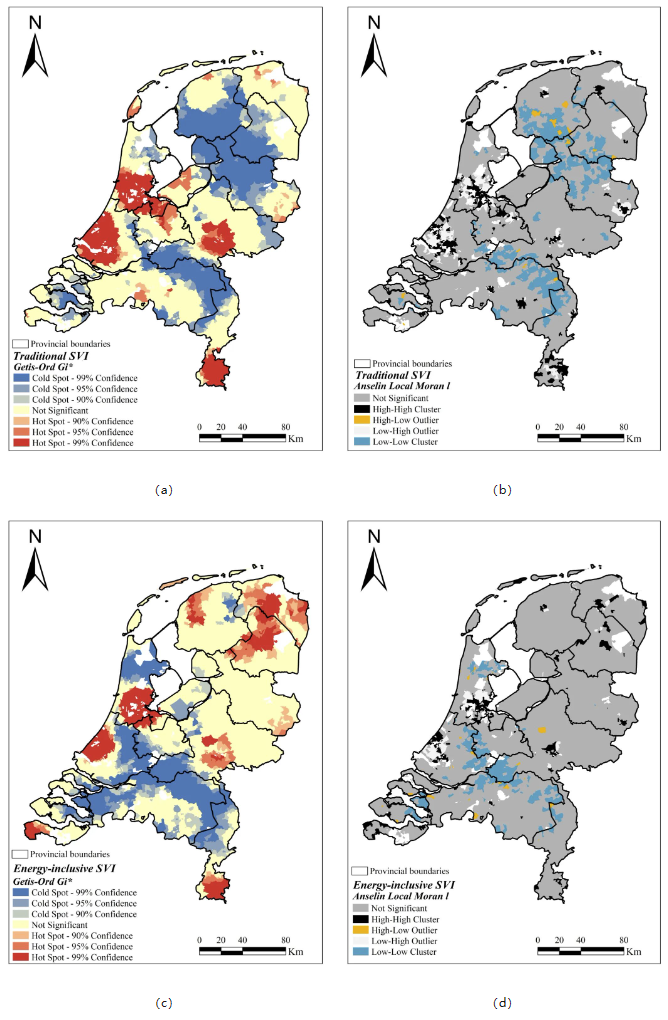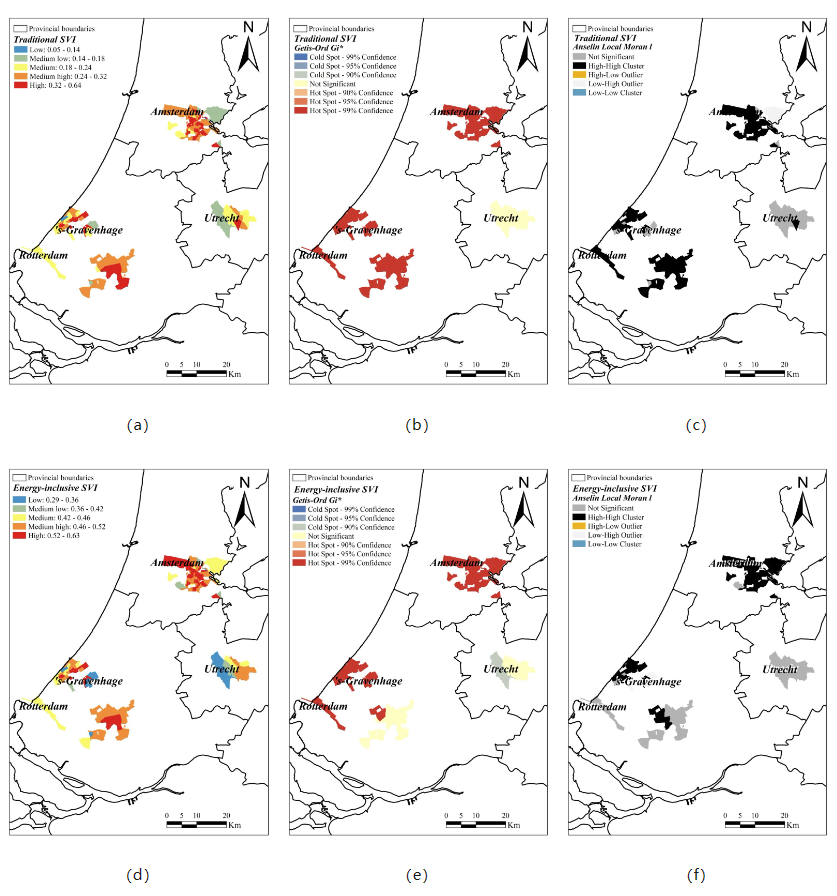学术快讯 | 利用能源韧性改进社会脆弱性评估,服务可持续城市未来治理
近日,上海交通大学设计学院风景园林系陈睿山教授团队在城市可持续发展国际重要期刊《Sustainable Cities and Society》(影响因子11.7,JCR/Q1,中科院SCI一区,Top期刊)发表学术论文“Enhancing social vulnerability assessment with energy resilience: A comprehensive study of the Netherlands”(利用能源韧性改进社会脆弱性评估:对荷兰的综合研究)。
从2021年河南郑州特大洪涝灾害大停电到德克萨斯州暴风雪大停电,能源系统韧性对城市灾害安全的影响越来越受到重视,然而,当前的灾害脆弱性评估中仍缺乏将能源韧性考虑进来的案例。论文因数据可得性,选择以荷兰为研究区,构建了一个新的考虑能源韧性的社会脆弱性指标(SVI)系统,比较传统框架和新框架的社会脆弱性结果,并寻找荷兰社会脆弱性的空间分布格局和特征。采用扩展能源指标的可持续城市脆弱性评估有助于消除国家内部和国家之间的脆弱性和不平等。研究结果为可持续城市的未来治理提供了更全面的参考,以实现国家和城市的包容性发展。
亮点
提出了一个包含能源的 SVI 指标体系,以提高复原力。
能源因素扩大了传统 SVI 系统的包容性和完整性。
能源包容性 SVI 揭示了潜在社会脆弱性的空间差异。
不均衡的城市化加剧了弱势群体的风险和不平等。
An energy-inclusive SVI indicator system is proposed to increase resilience.
Energy factor extends the inclusiveness and integrity of traditional SVI system.
Energy-inclusive SVI reveals spatial differences in potential social vulnerability.
Uneven urbanization exacerbates risks and inequalities for vulnerable groups.
摘要
全面的脆弱性评估是实现联合国可持续发展目标的科学基础。能源复原力在减轻灾害冲击造成的社会脆弱性方面发挥着至关重要的作用,能源基础设施和服务往往在灾害后崩溃。最近的俄乌战争加剧了欧洲的能源危机和社会脆弱性,这使得在脆弱性评估中增加能源复原力变得更加迫切。本文以荷兰作为脆弱性评估的研究区域,构建了一个新的社会脆弱性指标(SVI)系统,补充了能源元素,并与传统的能源指标系统进行了比较。
结果表明:1) 能源指标的引入填补了传统 SVI 评估的空白。2) 能源指标揭示了荷兰潜在社会脆弱性的地区和空间差异。3) 能源包容性 SVI 表明,不均衡的城市化加剧了弱势群体的风险和不平等,对社会脆弱性产生了潜在影响。城市的可持续发展需要寻求一种公认的、协调的方法来管理各地区的脆弱性。能源指标的互补性为更全面地评估社会脆弱性的空间模式、确定潜在的脆弱地区、提高城市抗灾能力和实现可持续城市发展提供了机会。
关键词:社会脆弱性;能源复原力;开放源普查数据;空间差异
Abstract
A comprehensive vulnerability assessment is a scientific basis for the realization of the United Nations' sustainable development goals. Energy resilience plays a crucial role in mitigating social vulnerability due to disaster shocks. Often, energy infrastructure and services collapse after disasters. The recent Russia-Ukraine war has exacerbated Europe's energy crisis and social vulnerabilities, making it even more urgent to add energy resilience to vulnerability assessments. This paper takes the Netherlands as the study area for vulnerability assessment, constructs a new social vulnerability indicator (SVI) system supplemented with the energy element, and compares that with the traditional energy indicator system.
The results indicate that: 1) The introduction of energy indicators fills the gap of traditional SVI assessment. 2) Energy indicators reveal regional and spatial differences in potential social vulnerability in the Netherlands. 3) Energy-inclusive SVI demonstrates that uneven urbanization exacerbates risks and inequalities for vulnerable groups, with potential impacts on social vulnerability. Sustainable urban development requires the search for a recognized and coordinated approach to managing vulnerability across regions. The complementarity of energy indicators offers opportunities to provide a more comprehensive assessment of spatial patterns of social vulnerability, identify potentially vulnerable areas, enhance urban disaster resilience, and achieve sustainable urban development.
Keywords: Social vulnerability; Energy resilience; Open-source census data; Spatial disparities
图 1. 荷兰的地理环境和四个最大的城市
(阿姆斯特丹、鹿特丹、海牙、乌得勒支)

图 2. 能源包容性 SVI 因素的空间分布图
(a) 社会程度,(b) 家庭能源和便利性,(c) 劳动脆弱性,(d) 太阳能尺度,(e) 教育,(f) 水体。
图 3. 荷兰传统 SVI(a)和能源包容性 SVI(b)得分的空间分布。

图 4. 荷兰传统 SVI 和能源包容性 SVI 的聚类特征
(a) 传统 SVI 的热点/冷点,(b) 传统 SVI 的局部莫兰指数,(c) 能源包容性 SVI 的热点/冷点,(d) 能源包容性 SVI 的局部莫兰指数。

图 5. 四个主要城市的传统 SVI 和能源包容性 SVI
(a) 传统 SVI 的空间分布,(b) 传统 SVI 的热点/冷点,(c) 传统 SVI 分数的局部莫兰指数,(d) 能源包容性 SVI 的空间分布,(e) 能源包容性 SVI 的热点/冷点,(f) 能源包容性 SVI 分数的局部莫兰指数。
上海交通大学设计学院风景园林专业硕士生宋雯为论文第一作者,通讯作者为荷兰布雷达应用科学大学人工智能、游戏与媒体学院邬骏教授和密歇根州立大学农业与自然资源学院系统集成与可持续发展中心贾楠博士,论文合作者有上海交通大学设计学院陈睿山教授,以及上海交通大学设计学院博士生李因帅和华东师范大学地理科学学院硕士生程杰。
引用格式:
Song, W., Li, Y., Cheng, J., Chen, R., Wu, J., & Jia, N. (2024). Enhancing social vulnerability assessment with energy resilience: A comprehensive study of the Netherlands. Sustainable Cities and Society, 103, 105251.